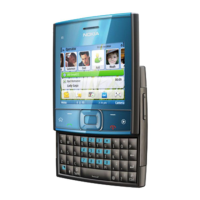should never rely solely on any wireless device for
essential communications like medical emergencies.
Make an emergency call
1 Ensure the device is switched on.
2 Check for adequate signal strength. You may also
need to do the following:
• Insert a SIM card.
• Remove call restrictions you have activated for
your device, such as call barring, fixed dialling,
or closed user group.
• Ensure your device is not in an offline or flight
profile.
3 To clear the display, press the end key as many times
as needed.
4 Open the slide, and enter the official emergency
number for your present location. Emergency call
numbers vary by location.
5 Press the call key.
When making an emergency call, give all the necessary
information as accurately as possible. Your wireless device
may be the only means of communication at the scene of
an accident. Keep the slide open and do not end the call
until given permission to do so.
Certification information (SAR)
This mobile device meets guidelines for exposure to
radio waves.
Your mobile device is a radio transmitter and receiver. It
is designed not to exceed the limits for exposure to radio
waves recommended by international guidelines. These
guidelines were developed by the independent scientific
organisation ICNIRP and include safety margins designed
to assure the protection of all persons, regardless of age
and health.
The exposure guidelines for mobile devices employ a unit
of measurement known as the Specific Absorption Rate or
SAR. The SAR limit stated in the ICNIRP guidelines is 2.0
watts/kilogram (W/kg) averaged over 10 grams of tissue.
Tests for SAR are conducted using standard operating
positions with the device transmitting at its highest
certified power level in all tested frequency bands. The
actual SAR level of an operating device can be below the
maximum value because the device is designed to use only
the power required to reach the network. That amount
changes depending on a number of factors such as how
close you are to a network base station.
The highest SAR value under the ICNIRP guidelines for use
of the device at the ear is 0.73 W/kg.
Use of device accessories may result in different SAR
values. SAR values may vary depending on national
reporting and testing requirements and the network
band. Additional SAR information may be provided under
product information at www.nokia.com.
112 Product and safety information
© 2010 Nokia. All rights reserved.

